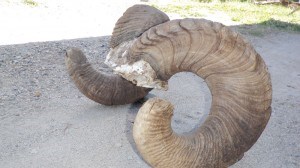
One of the amazing experiences of living in Jasper National Park is the opportunity to see wild animals living free in their natural world. Given the size of Jasper, the variety of activities and the nearly two million visitors every year, it takes a conscious effort from each of us to make sure we do not harm the very thing that makes the park special: its wild nature.
As you explore the park in your own way, be it by foot, on wheels, or by air, keeping your eyes open and senses tuned to your surroundings can keep both you and the wildlife around you safe.
Reporting
To help monitor the park’s wildlife and ensure the safety of people in the park, we ask that you report all large carnivore sightings, including bears, wolves and cougars. As well, while out and about in the park if you notice injured animals or anything unusual, we ask that you report it.
As a recent example, Parks Canada wardens are looking for any information regarding a large set of bighorn sheep horns discovered during the last week of April along a popular trail between Highway 16 and the Miette River.
A member of the public walking their dog in the vicinity reported that the trophy-size horns appeared to have been cut from the skull with a saw. There are no sheep naturally found near this location. The horns are believed to be from a winter kill animal that must have been picked up elsewhere and placed in the area. The saw marks on the skull indicate that someone had intentionally removed the horns from the skull.
It is a serious offence under the Canada National Parks Act to, except as permitted by the act, possess any part of an animal in a national park.
If you have any information, please contact Crime Stoppers at 1-800-222-8477 or online at www.crimestoppers.ab.ca. Information can be given anonymously. Alternatively, contact Jasper National Park wardens toll free at 1-877-852-3100, or [email protected].
Elk Calving
It is spring and that means elk calving season. Elk calve from mid-May till the end of June. Elk mothers are very protective of their young and may behave aggressively at this time of year.
If you run into elk, watch for the following behaviours as signs to steer clear:
- staring intently;
- folding their ears forward;
- raising the hair on their rumps;
- grinding their teeth;
- curling their lips; and
- following or circling around people on trails
To avoid an elk encounter:
- Travel in a group on trails and carry a walking stick, pepper spray or an umbrella for protection
- Watch for single cow elk. She could be staking out a calving spot or have a calf already, and won’t re-join the herd until the calf is at least 10 days old.
- If you see a calf elk, immediately leave the area—the cow elk is not far away.
Stay back at least 30 metres, and preferably 100 metres, from elk.
Parks Canada
Special to the Fitzhugh
